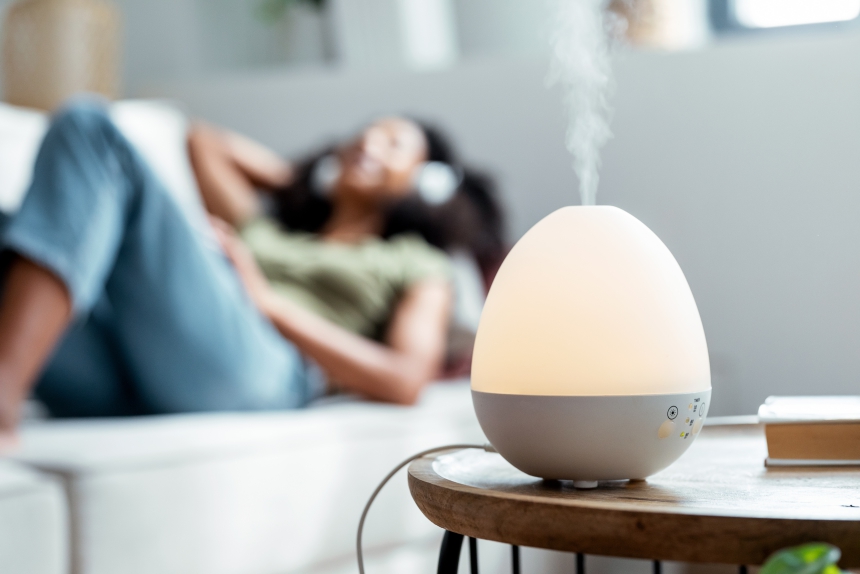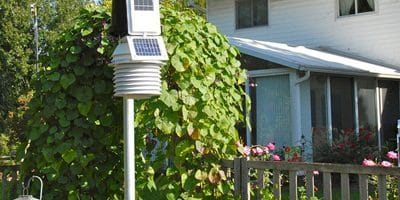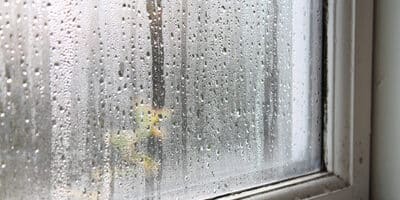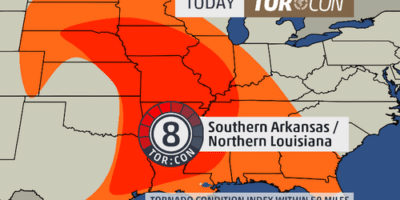
When it comes to the differences between a diffuser vs. a humidifier, you may have some burning questions.
For instance, have you ever wondered if diffusers and humidifiers are interchangeable? In other words, can you use a diffuser as a humidifier to add moisture to the air inside your home? Can you put essential oils in a humidifier to make your home smell pleasant?
In this article, you’ll find the answers to these common questions. Plus, you will discover all the significant differences between a diffuser and a humidifier. Then you’ll be able to make the right decision and buy the best device for your home.
Who knows? You may realize both a diffuser and a humidifier may meet your indoor air quality needs and be welcome additions to your home.
Our team of editors independently research, test, and recommend the best products to help you navigate when shopping online. This post contains compensated links, and if you make a purchase using the links included, we may earn a commission. To learn more, read our disclaimer.
What’s the Difference Between a Diffuser and a Humidifier?
Although both humidifiers and diffusers (ultrasonic diffusers) emit water vapor into the air, they are not the same. They primarily serve different purposes. The primary purpose of a diffuser is to disperse essential oils into the air to provide a pleasant scent and relaxing aromatherapy benefits. In comparison, the purpose of a humidifier is to emit moisture into the air to raise the indoor humidity to a comfortable and healthy level.
Can You Use a Diffuser as a Humidifier?

Essential oil diffusers are not designed to humidify indoor air. While ultrasonic diffusers can dispense water along with essential oils, the amount of moisture they can hold and disperse is negligible compared to what a humidifier can release. You can’t use a diffuser as a humidifier and expect noticeable results. The moisture from an essential oil diffuser is not enough to impact the relative humidity level in a room.
Remember, a diffuser’s primary purpose is to disperse essential oils, while a humidifier will add humidity to the air as fast as possible. Our top-rated large essential oil diffuser (ultrasonic model), the Exqline 1500ml, can emit only 1.5 liters of moisture in 10 hours when set on high mist mode. Even if your indoor air is extremely dry, you’ll notice little change in the humidity level from this amount of moisture.
In comparison, our top-rated large space humidifier, the Levoit LV600HH, will emit 5 liters of moisture over the same 10-hour period in high mist mode. Designed for large rooms and with a built-in, programmable humidistat, the Levoit LV600HH will ensure your indoor humidity is at a healthy level. All the time.
If your main objective is to increase the relative humidity level inside your home, a humidifier will be more efficient and effective than an essential oil diffuser.
Can You Put Essential Oils in a Humidifier?

Most humidifier manufacturers don’t recommend adding essential oils to their humidifiers. The internal parts aren’t designed to work with essential oils, and it could disrupt the regular operation of your device. The oils could erode the plastic tank, damage internal parts, and clog the filter of your humidifier. However, some humidifiers—such as the Levoit LV600HH—have a designated tray with an essential oil pad, then it is permissible to add essential oils.
In humidifiers with this built-in essential oil compartment, the oils are not in contact with the water reservoir, the base, or filters where it could leave a damaging oily film.
Besides these negative consequences, essential oils are expensive. During regular operation with a humidifier running on a full tank of water, the aroma from a few drops diluted in a humidifier’s large water tank (5-6 liters) would likely not be detected even by someone with an exceptional sniffer.
Suppose you added more drops to the tank, proportional to the recommended 3-5 drops per 100 milliliters of water in a diffuser. In that case, you’d go through several bottles in just one week with regular humidifier use. That will quickly amount to an unexpected expense in just one season!
If you want to experience the full benefits of aromatherapy, we recommend using essential oils in a diffuser, particularly in a nebulizing diffuser, such as the ArOmis nebulizer.
A nebulizing essential oil diffuser will fill a room with a scent quicker than any ultrasonic diffuser as they diffuse essential oils in their purest form—without heat or dilution.
When to Use a Diffuser and Its Benefits

Are you looking to change the ambiance in your home? Or maybe you need a mood booster? Then aromatherapy from an essential oil diffuser will be perfect for you.
Diffusers add a pleasant fragrance to your home by spreading the aroma of essential oils. The practice of aromatherapy has many therapeutic benefits, which include reducing stress and anxiety, improving sleep, aiding in relaxation, promoting a sense of calm, enhancing clarity, and boosting your mood.
Types of Diffusers
Here’s a brief rundown of the types of diffusers that are available today.
1. Ultrasonic Diffusers
Through high-frequency vibrations in water, ultrasonic diffusers dispense essential oils in a fine mist of water vapor throughout your airspace. Ultrasonic diffusers are easy-to-use, they’re safe, and also efficient. However, they require routine cleaning and upkeep, and because of the dilution, the aroma can be subtle if you don’t use enough drops of essential oil.
2. Nebulizing Diffusers
Using high pressure, nebulizing diffusers force compressed air through a glass tube in small bursts, creating an intense and concentrated mist of aroma. Nebulizers don’t dilute oils in water, and they also don’t use heat which leaves the oils in their purest form to create a powerful aroma that can fill a room faster than any other type of diffuser.
3. Reed Diffusers
Reed diffusers hold a base solution usually made up of water and alcohol with essential oils in a glass bottle. Long rattan reeds are placed in the bottle protruding out the top. The reeds absorb the mixture up to the ends, and then the solution naturally evaporates into the air while spreading a pleasant aroma.
4. Evaporative Diffusers
Evaporative diffusers use airflow to evaporate and disperse oils throughout a room. A fan blows air through an absorbable surface, either a filter or pad with oils dropped onto it. The moving air causes the oils to evaporate quickly and disperse throughout the room.
5. Heat Diffusers
Essential oils are placed in a tray close to a heat source, and sometimes the oils are mixed with water. The heat is applied to the tray, either with a heating element powered by electricity or from a candle which then evaporates the oils into the air. Unfortunately, heat can change the overall composition of the oils, which may inhibit their full therapeutic benefits.
When to Use a Humidifier and Its Benefits

Suppose the humidity level is too low in your home, and you’re experiencing the symptoms of uncomfortably dry air. A humidifier will solve the problem by adding moisture to your airspace and raising the indoor humidity level.
Humidifiers are very useful in alleviating symptoms associated with dry indoor air, like dry skin, itchy skin, and chapped lips. A humidifier can also prevent nosebleeds caused by nasal dryness. They will make breathing easier in people with allergies or asthma, or if you’re stuck inside with bronchitis or a cold, a humidifier can help.
A humidifier will also prevent the wooden materials inside your home, such as furniture and floorboards, from drying out, cracking, and splitting.
According to the U.S. Environmental Protection Agency, 30-50% indoor humidity is optimal for a healthy environment at home. A portable hygrometer will indicate the indoor humidity level so you know how much moisture your home needs (find a suitable model here). A built-in, programmable humidistat that accompanies most humidifiers will control the exact amount of moisture released by the device.
Types of Humidifiers
Let’s take a look at the four main types of humidifiers available to purchase.
1. Ultrasonic Humidifiers
High-frequency vibrations from a small diaphragm in the water tank create a fine mist that disperses throughout a room to add moisture to dry air. Cool mist humidifiers or ultrasonics don’t need a noisy fan, making them super quiet and perfect for overnight use in a bedroom. However, they will require routine cleaning and maintenance to prevent mold and bacteria growth.
2. Evaporative Humidifiers
A wick filter draws water from a tank, and a fan blows dry air through the wet wick filter. The moist air then circulates and naturally evaporates throughout your home, increasing the humidity.
3. Steam Vaporizers
Through a heating element that boils water, a vaporizer creates steam that emits into the air as a warm mist. Be careful—these gadgets can be dangerous for kids because of burn risks.
4. Whole-House Humidifiers
A more expensive and permanent solution where a humidifier is connected to your home’s central heating, ventilation, and cooling (HVAC) system. Moist air travels throughout the ductwork equally to all parts of your home.
Final Thoughts
While an ultrasonic diffuser can add moisture to the air, the amount is insignificant compared to a humidifier. You can use essential oils with compatible cool mist humidifiers, but that’s not its primary purpose, and it won’t be as effective as a diffuser.
Now with a better understanding of the differences between a humidifier vs. a diffuser, it’s time to decide which device will best suit your needs.
We recommend having both devices in your home to create a relaxing and healthy environment efficiently. If your goal is to increase the moisture in your home because of dry air, turn on the humidifier. If you want to practice aromatherapy and spread a pleasant scent throughout your home, turn on the diffuser—of course, both can run simultaneously.
Our top picks are the Levoit LV600HH ultrasonic humidifier and the ArOmis nebulizing diffuser. If you prefer an ultrasonic diffuser, try the Exqline 1500ml.




